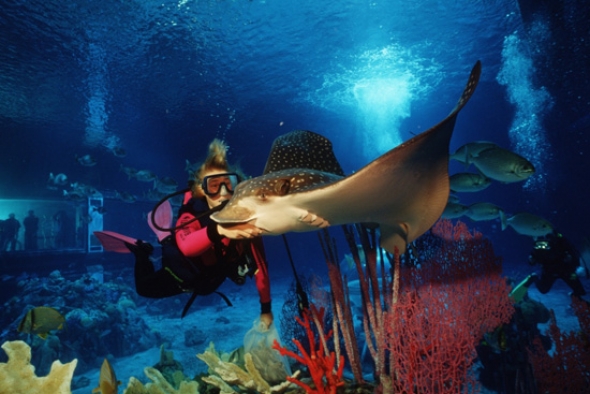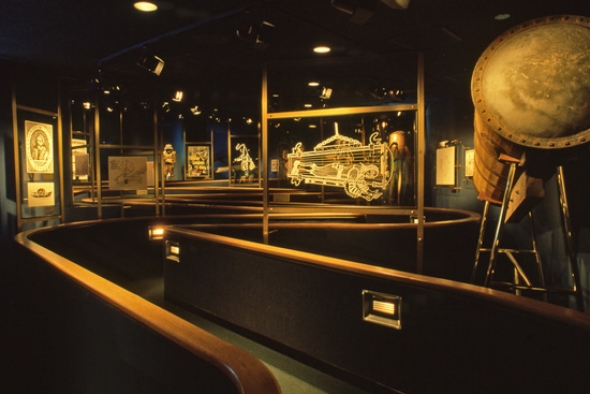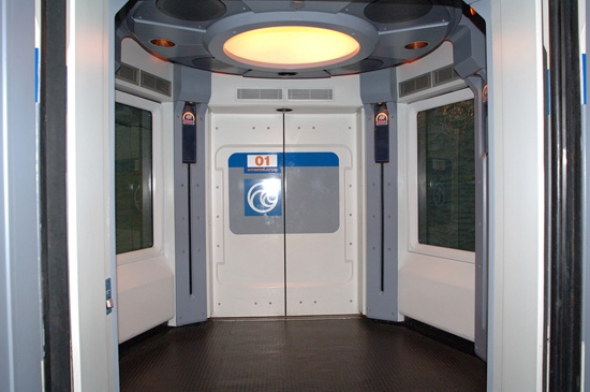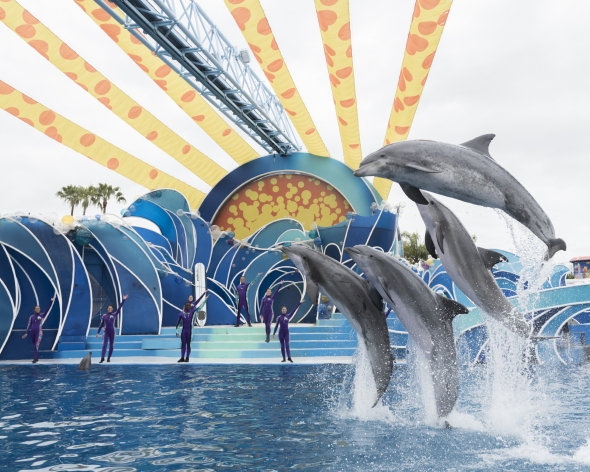The world’s sixth largest ocean
Image: Disney
Okay, that’s a slight exaggeration. The precise term is that The Living Seas instantly became the sixth largest ocean manufactured by mankind. It wasn’t as big as actual oceans, of course, but it was one of the most impressive feats ever accomplished by human construction to that point. The fact that Epcot still uses the body of it 30 years later reinforces Disney’s greatness in building this phenomenal architectural triumph.
Even though sacrifices were made that lessened the pavilion from its potential status as the greatest thing in theme park history, it has still stood the test of time. The Living Seas is something SeaWorld execs could only dream of bringing into reality. On opening day, guests witnessed cast members swimming through the depths of this artificial ocean. The Disney employees loved to display the nautical acrobatics possible within the enormous saltwater tank. With a wetsuit, an oxygen tube, and goggles, they could mimic virtually anything that a deep sea diver does during their time underwater.
The fun and games aspect of The Living Seas was a side benefit rather than a true purpose, though. Disney leaned on the side of science and academics when they finalized construction details. The heart of the building, the portion that guests still enjoy today, is Sea Base Alpha. Imagineers crafted a quasi-futuristic “underwater” laboratory. It was so plausibly science fiction in look and style that a 1990s series called SeaQuest DSV actually filmed there.
Sea Base Alpha offered several attractions, almost all of which were informational in nature. The dive tank chamber and wave tank showed off the latest in underwater technology, highlighting the gear that would allow people to spend more time under the sea, and in a more comfortable manner to boot. Cast members would swim in these waters, demonstrating near-future wetsuits and the like. The wave tank also revealed the impact that the tide has on the otherwise unseen depths of the ocean floor.
Image: Disney
The first floor of Sea Lab Alpha also included several aquatic modules. In these sections, guests could watch marine life in its natural habitat (and the same was true of the marine life with humanity). Ecosystems included a coral lagoon with countless starfish and other sea creatures, a viewing center for manatee interactions, some maps and educational videos/imagery, and an Audio-Animatronic whose sole purpose was to hype the future explorative value of underwater robots. Cast members also schooled observers in the nature of various fish.
The second floor was more of the same, sometimes literally. A couple of the main exhibits were (more than) two stories tall, so the higher floor provided a different view of the same activities. The Observation Deck was the seminal part of the top floor of Sea Lab Alpha. Its sole purpose was to display as many of the elements of The Living Seas aquarium as possible.
The design of Sea Lab Alpha wasn’t a product of happenstance. A few years prior, park planners felt pressured to throw out the grand design of a single immersive attraction. They’d intended to build an entire exhibition. It would begin the instant the park visitor boarded the transparent bubble and rode to the underwater laboratory. Their vision was of an all-encompassing underwater dome city experience. When the bean counters said no, many of the ideas Imagineers saved became truncated. Disney compartmentalized each one in a single section of The Living Seas. By definition, the modules made a trip through the pavilion modular in nature. The compromises lessened the impact of a visit to a water realm beneath Earth’s surface.
While kids loved seeing the fish and remembered the Observation Tower and other exhibits vividly years later – and I speak from experience here – they bored quickly of the stuffier elements of The Living Seas. Watching fish is fun for a few minutes. Then, it gets old fast. As for the educational elements, Disney deserves tremendous credit for their decision to prioritize knowledge over entertainment. It was the opposite of SeaWorld’s strategy. Unfortunately, kids have a heavy favorite in this race, and it’s not knowledge. That’s why Epcot’s decision makers eventually redesigned The Living Seas with a more child-friendly theme. We’ll get to that in just a moment. Before then, let’s discuss the pink elephant (well, dolphins) tap dancing in the living room.
Fish stories…
Image: Disney
“We won’t commercialize sea life. There are no tricks here.”
The above quote comes from a Disney spokesperson on the day that The Living Seas debuted. The employee was understandably proud of the seventh pavilion at Epcot, and they didn’t back away from the pointed comments about other, more social water-based entertainment facilities. In fact, the PR rep quickly doubled down.
“Dolphins don’t jump through hoops in the ocean. They won’t do it here. Sharks don’t go around eating boats or cities. They won’t do it here. If you see some showgirl riding a porpoise, you’re at the wrong place. Living Seas’ focus is educational, not Hollywood.”
Yes, that’s a shot at SeaWorld, Universal Studios, and any number of low-rent amusement parks all in a single, vaguely condescending quote. Disney employees felt confident that their company was going to do everything right, and they felt this way due to past experience. A decades-long track record of excellence builds faith. Alas, some things in life are beyond the control of even the greatest professionals.
Image: SeaWorld
I won’t recount the Blackfish incident and how it’s destroyed SeaWorld. Let’s simply acknowledge that many individuals feel conflicted about the capture and harboring of mammals in small environments. Even as Disney sought to differentiate itself from SeaWorld, they employed some of the same practices, largely because they were commonly accepted ones in the mid-1980s. The public perception of these capturing methods didn’t change until the 21st century.
Veterinarian Jay Sweeney was the focal point of Florida dolphin captures during this era. He was a co-director at Dolphin Services International, and he proudly proclaimed that he’d taken 80 dolphins out of their natural habitats. He performed these captures on behalf of theme parks like SeaWorld, knowing that the industry needed dolphins. They were the friendliest and most popular creatures at the parks, and they could perform tricks to boot.
When Epcot analysts plotted strategies for The Living Seas, they knew that dolphins would attract huge crowds. They hired the services of Sweeney and other dolphin trainers in the region, understanding that training was frequently code for capturing in the wild. That’s the first misfire from Disney park planners. They didn’t anticipate that removing a cuddly dolphin from its natural habitat can turn the creature into a killer. In their defense, who expects dolphins to turn feral?
Delivering the dolphins to Disney
During the 1980s, Sweeney was one of only a handful of federally approved supervisors for dolphin collection. He was also quite good at his job. The veterinarian captured a total of six dolphins for Epcot, two of which were female, and he did so in a much quicker timeframe than Disney had projected.
As for his qualifications, Sweeney was entrusted with their caretaking by the federal government. His professional reputation was above reproach. A 1991 Los Angeles Times article detailed his capturing philosophies:
“Sweeney - -one of the world's leading marine-mammal veterinarians -- generally uses conservative methods for catching dolphins. He's never captured more than two or three dolphins on a given day; he personally monitors the animals for signs of shock and supervises their adjustment to captivity. "If I don't like the way an animal is developing, I always err on the side of safety and release it," he says. "We have never killed an animal in a capture operation."”
If you’re wondering, Disney didn’t hide their intentions, either. To the contrary, the company planned a photo shoot for Sweeney’s dolphin hunt. They also filmed the events for posterity’s sake. You can watch some of the footage here. In the build-up to the opening of The Living Seas, nothing the company or Sweeney did was considered unbecoming. Had they only caught five dolphins, the entire perception of their dolphins captures might have been perceived differently.





Comments
I fell in love with the old Epcot. The music, the originality and, at the time, the future. It didn't take long for the future blow away Epcot and for several years there Epcot lost its relevance. Those who were going were freaks like me wanting to experience "nostalgia." Trivia question for only the true Epcot nerds: There was a cool "intro movie" to one of the exhibits where she dramatically and almost with an English accent says after a second of silence, "THE DELUGE..." Which exhibit was that? Anyone?? LOL!